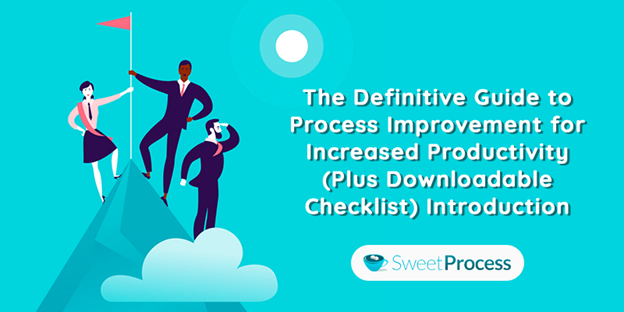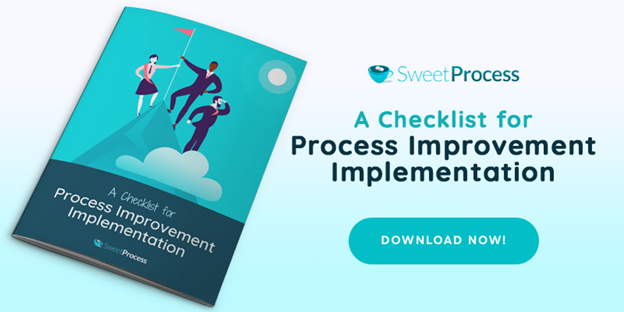The Definitive Guide to Process Improvement for Increased Productivity (Plus Downloadable Checklist)
Last Updated on March 27, 2024 by Owen McGab Enaohwo

Have you been struggling with process improvement and growth in your organization?
Do you want to have better processes that will help you drive productivity and sales?
Sometimes you might have a goal or strategy that can enhance your business but communicating this to your team becomes challenging.
Or perhaps you have put new processes in place but you want to follow up to check on the progress.
To overcome this, you need a solution that can help you evaluate your current process and create steps that will improve the existing process.
To execute every operational process improvement efficiently, you need insights and tools into every step.
And you also need time-tested, data-driven approaches to enhancing processes. This improvement should be worth at least five times your ROI (return on investment).
In this article, we will walk through the details of how you can transform your organization using the right software and technique for your process improvement effort.
Chapter 1: What is Process Improvement?
Chapter 2: Steps to Implementing Process Improvement
Chapter 3: Process Improvement Techniques
Chapter 4: How to Remain Focused on Process Improvement
Chapter 5: Automating Process Improvement With the Right Software
Chapter 1: What is Process Improvement?

Process improvement refers to the act of analyzing—or examining—and improving existing processes.
It is an ongoing process that involves identifying, analyzing, and improving existing processes within an establishment.
The primary goal of process improvement is to ensure your business is running seamlessly at optimal levels to meet quality benchmarks, standards, and quotas.
Process improvement generally follows a specific methodology. However, there are several approaches to process improvement.
The most common approach to process improvement is a wide range of lean manufacturing techniques.
Each of these techniques focuses on a particular area of improvement.
During process improvement analysis, processes are modified, eliminated if necessary, or added to by utilizing several sub-processes.
Process Improvement Applications
You can apply process improvement in three significant areas, which are:
- Operational: This has to do with the core business and creating value streams such as opening accounts, customer orders, manufacturing, etc.
- Management: This includes processes such as corporate governance, employee and budget oversight, etc.
- Support: This includes every process that supports all other processes, such as recruitment, accounting, technical support, etc.
Benefits of Process Improvement
The need for process improvement cannot be overemphasized. Here are some of the benefits of process improvement and how it can help you improve:
- Reduced Risk
One of the most significant risks any organization can take these days is manually transferring data between systems.
Human error is a common phenomenon, and some mistakes can take several hours or even days to rectify.
Manual systems significantly increase the risk of human error and fraud. Most employees not conversant with IT are usually assigned data management/entry tasks.
But most of them are usually not familiar with backup and storage best practices.
Process improvement highlights those areas or activities that can be automated, thereby cutting down the output period.
It also helps minimize human error and promotes additional security measures to protect company information or data.
- Increased Productivity
Some daily tasks, such as running reports, filling out hundreds of forms, etc., can confuse or frustrate employees.
These activities could take all day or countless hours if you stick to the old way of doing things.
According to a survey, employees could spend up to 520 hours every year working on highly repetitive tasks that you can automate using the latest technologies.
Introducing a customized app or new software to help your employees automate their day-to-day tasks can significantly boost productivity.
Employees will also reallocate regained hours to other core aspects of their respective duties or jobs.
- Enhanced Employee Satisfaction
Every well-developed business process motivates team members, especially those who don’t enjoy wasting time or money.
Well-executed business processes minimize repetitive, tedious tasks that typically run through limited brainpower and working hours.
Employees will focus keenly on those job functions they care about instead of searching endlessly for documents or entering data manually.
When a seamless procedure is in place, it results in a much happier and more functional workforce.
This results in higher productivity and increased revenue in the long run.
- Integration of Technology
Process improvement highlights the applications and software that best aligns with your company’s requirements.
The best solution for you may be a custom web application or commercially available software.
New technology should always support every new business process, e.g., from data entry to employee collaboration.
- Agility
To stay competitive in any industry today, your organization needs to have agile processes in place.
Business process improvement enables you to considerably—and constantly—improve processes to adapt to changing business needs.
You do not have to reinvent the wheel each time the winds of change blow across your industry or niche.
Process improvement is all about focusing on improving flexible processes that are incredibly easy to alter and deploy, even as your business needs continually evolve.
- Compliance
Another challenge that some organizations face has to do with compliance.
You could face unanticipated penalties if you do not have flexible systems in place that handle end-to-end compliance.
But via process improvement, your third-party consultant can conveniently document every compliance-related policy, procedure, and internal control.
When you integrate compliance into your brand-new processes, it creates transparency.
You will be able to implement regulatory requirements quickly, thereby preventing delays in both compliance and fines.
- Customer Satisfaction
According to a study conducted by Microsoft, over 90 percent of consumers would prefer taking their business elsewhere rather than transacting with an organization that still relies heavily on obsolete technology.
When you upgrade your tech solutions, you also cut down the time spent on typical administrative tasks.
Your empowered workforce will be free to focus much more on real-time collaboration with each customer.
This implies that your employees will have a much greater capacity to respond actively to customer requests.
They will build proposals faster and customize solutions within a shorter period.
In general, process improvement helps your team members focus only on activities that generate or deliver results for customers or clients, thereby increasing customer satisfaction.
How Business Process Improvement Complements Business Process Management (BPM)
Business process management (BPM) refers to the holistic approach to accomplishing every optimized business outcome.
It enables companies to align each business function with customer needs while helping executives figure out how to implement, monitor, and measure the organization’s resources.
If executed properly, business process management can boost productivity and efficiency, minimize costs, and eradicate risks and errors.
Business process improvement is all about improving manufacturing processes, and this easily complements business process management, resulting in the following tangible benefits:
- Cost reductions
- Risk management
- Revenue growth
- Productivity improvements
- Enhanced customer experience
- Compliance
- Digital transformation, etc.
Process Improvement Jobs
Process improvement is a concept that high-level businesses adopt, and it is not a job title.
You will discover that several titles fall under the process improvement concept.
There are more than a few jobs listed under continuous improvement manager or process improvement manager.
According to data obtained from PayScale, the average take-home salary for a continuous improvement manager is $83,000 per annum, while process improvement managers earn up to $82,000 per year.
Process improvement directors also report average salaries of $110,000 per annum.
Other job titles associated with business improvement processes and their respective yearly salaries on average are:
- Operations excellence manager: $105,000
- Process analyst: $60,000
- Process improvement engineer: $70,000
- Lean process improvement manager: $87,000
- Business process analyst: $64,000
- Continuous improvement specialist: $62,000
- Process engineer: $72,000
- Business process technology analyst: $73,000
- Process architect: $95,000
Process Improvement Examples
Since business process improvement involves the practice of pinpointing and implementing valuable changes to processes, we will cover a couple of process improvement examples with which you may identify.
Health and Safety
Before any surgical operation, the hospital where the procedure takes place uses ink to mark and color the correct areas for the procedure.
It usually involves multiple confirmation processes, and even the patient may be required to make some confirmations, if possible.
The process ensures that the procedure only focuses on the marked areas and not any other place.
Bottlenecks
Let’s assume that it takes up to eight weeks for a particular office to issue a passport, and six of those weeks center on security processes.
The entire process is resource-intensive, and the department in charge is never in a hurry.
The security check can be skipped entirely, especially for straightforward renewals eliminating this bottleneck.
In such instances, the security process is not likely to identify any issue.
Doing this will minimize the workflow considerably, thereby improving the department’s performance by up to two weeks.
And now, the office will be able to issue valid passports within just two to four weeks.
Now that we have seen the basics, the next thing is to cover the steps to implementing process improvement in your organization.
Chapter 2: Steps to Implementing Process Improvement

The continuous improvement of your business is the primary goal of process improvement.
To move your ideas or concepts from mere paperwork to reality, you need to take some actionable steps.
Step #1: Map Out the Current Process
Before doing anything else, the first thing you and your team should do is look thoroughly into the current process.
Map out the current steps to the process visually to readily pinpoint areas that require significant improvement.
Many companies use pictorial diagrams like flow charts, etc., to precisely visualize how every step flows from one to the other.
Step #2: Analyze the Process
Using the pictorial diagram you just mapped out in the previous section, carefully examine every step alongside your team.
Speak with the operators of the processes to identify places or spots where delays generally occur routinely.
It would help determine where you spend too much money without using too many resources for too little outcome or results.
The most crucial aspect of this second step is discovering the root cause of these problems.
Therefore, do your best to figure out the precise location of the problem, or you won’t understand how to fix it. At this point, you can adopt strategies such as Six Sigma or the root cause analysis methodologies.
Step #3: Identify the Processes That Need to Be Improved
This step may require you to create another diagram as you share ideas with members of your team.
As you take steps to identify the process that requires improvement, you need to provide answers to the following questions:
- What is the primary purpose of this workflow or activity?
- Do redundancies exist anywhere?
- What are the problems, compliance, and quality issues, and why are they occurring?
- What are the major problems?
- Does automation properly support this task?
- How can these problems be eliminated?
- Can wastes be removed? How do we go about it?
- How can we track the activity to ensure maximum performance?
Supplying answers to these questions will help to identify the processes that require significant improvement.
Step #4: Create a New Design for the Process
After identifying issues and the root causes of these problems, the next step is to create a new design for the process.
You are creating new designs for processes that help do away with the problems you have just discovered.
Bear in mind that this will require the contributory effort of your entire team. However, when you involve every team member in this step, you fully understand the aging process that you plan to update.
Therefore, consider every team member’s ideas during your brainstorming sessions.
For each concept or idea put forward by team members, consider how affected team members will perform the redesigned process, the potential risks involved, how long it will take to complete from start to finish, etc.
Step #5: Assign Resources for the Execution
The execution is the step that involves discussing what will be required to make the necessary changes.
You need to also think about every department that this unexpected change may considerably impact. To achieve this, you need to thoroughly discuss the proposed changes with other managers in the organization.
Inform everyone who may be affected by the significant changes of the new process what it entails, its impact on their current positions or jobs, and how it affects the entire organization.
Step #6: Design a Plan for the New Process
By now, every individual within the organization should be fully aware of their new roles. They should also have the resources required to implement the new process.
Create a detailed plan that contains the specific task each individual or employee will be working on and the resources they need.
Develop a timeline that showcases when every task will begin and end by using specific dates for the activity.
Step #7: Execute the New Plan
Despite everything, the most vital aspect of this step is communication. Before taking any action, ensure each affected team member is well aware of the new process’s implementation plan.
This is why it is vitally important to keep everyone in the loop of all process changes so that they don’t resist brand-new processes.
Activate the plan and put it into action by carefully following the implementation plan you developed in the previous step.
Step #8: Carry Out an Audit to Optimize and Keep Improving
Since the primary goal is continuous process improvement, your work is never completed or done but remains a continuous or non-stop effort.
Once the new process kick-starts and swings into action, create a plan for a period down the road for carrying out an audit on the brand-new changes.
Systematic process improvement audits are essential as they help ensure team members follow the brand-new processes to the letter, as outlined in the implementation plan.
Regular audits also help spot bottlenecks that may arise unexpectedly, enabling you to work closely with the employees to get past the chokepoints.
If, at this point, your team needs a better understanding of what needs to be done, then you should consider training. This takes us to process improvement training…
Process Improvement Training
Effective utilization of process improvement skills within a company leads to better service/product quality, enhanced productivity, customer satisfaction, loyalty, and a higher—and faster—return on investment.
This is why the importance of process improvement training should not be taken for granted.
It is highly imperative and recommended for managers to undergo process improvement training if they lack the skills to implement changes that enhance the productivity of activities within processes in an organization.
Since you already know that a process improvement culture is never an out-of-the-box solution, striving to improve these processes should be one of the organization’s ultimate goals.
This is why businesses should always look for opportunities for boosting efficiency levels, using fewer resources or reducing costs, and enhancing productivity via process improvement training.
Chapter 3: Process Improvement Techniques

Several methodologies exist which are designed to assist your organization in taking up process improvement.
Each methodology aims to help your company identify process problems, fix every one of them, and analyze the overall success—or failure—of the changes implemented.
Despite the standardized goal, every methodology is suitable for a particular need.
Some of these frameworks only work seamlessly on lean process improvement techniques, while others focus only on getting your organization culture in just the right places for process improvement.
Some methodologies help organizations visually map out process workflows. Here they are in no particular order:
5S
5S refers to the name of a workplace company method that was initially applied during manufacturing.
However, several organizations have since discovered that 5S is a highly effective method of achieving rapid, non-stop improvement.
5S generally revolves around five ideas that make employees much more efficient and effective in their respective duties or work. The name was coined since every one of these five principles starts with the letter “S.”
Let’s break it down:
- Sort: You should only keep what is used regularly close at hand.
- Straighten: Organize the space such that employees can easily find what they need to use within 30 seconds.
- Shine: Ensure the equipment and workplace are always ready for immediate use.
- Standardize: Every job is executed the same way, and every worker is challenged to offer ideas to improve it significantly.
- Sustain: Encouraging the development of an efficient, safe, and highly effective workplace is every person’s responsibility.
Belts
To be more precise, belts—or Lean Six Sigma belts—refers to different stages of knowledge, skill, and experience within a process improvement practitioner’s development.
These well-defined roles help structure a company’s continuous improvement strategy since every belt level plays a crucial part in the overall success of Lean Six Sigma programs or initiatives.
There are five belt levels:
- White Belt: Refers to the general understanding of precisely how Lean Six Sigma works. Involves correct Lean Six Sigma terminologies to efficiently communicate potential problems or relevant points to the team working on process improvement projects.
- Yellow Belt: Refers to the awareness of foundational concepts
- Green Belt: Denotes the proficiencies in using field tools such as DMAIC methodology, etc.
- Black Belt: Involves leading full-time projects and expertise in several areas like design of experiments, etc.
- Master Black Belt: Denotes the expert level of a professional who already has a black belt certification for a minimum of two years. The individual must have mastered the discipline to teach its tenets to other upcoming professionals.
Business Process Modeling Notation (BPMN)
A business process modeling notation (BPMN) map refers to the standardized method of creating visual models of your business processes.
This methodology is used in all types of industries, especially by business analysts.
It helps identify errors in processes, helping stakeholders fully understand how the business operates, breaking down business processes for easy analysis, and designing brand-new processes.
Cause and Effect Analysis
One of the best ways of resolving problems is by, first of all, exploring every possible cause. A cause-and-effect analysis approach offers a structure for this type of assessment.
This involves considering six causes or areas that can easily contribute to a characteristic effect or response: machine, materials, personnel, method, environment, and measurement.
When you use this approach to evaluate problems, the solutions may become apparent almost immediately. But, of course, in some other cases, the initial cause might still not be apparent.
Nevertheless, statistical analyses of historical data can be employed to test out several theories.
And this information/data can be used to bring about insight into what can be done to improve a 30,000-foot-level process output baseline performance considerably.
DMAIC
DMAIC is another project methodology involving five phases: defining, measuring, analyzing, improving, and controlling. These are steps employed in ensuring that data—repeatable and measurable—drive every improvement.
The DMAIC improvement cycle—as it is popularly known—is a highly efficient technique for structured change measurement.
The emphasis on analysis and measurement helps ensure every opportunity for improvement is performed to guarantee the most positive impact.
Let’s break DMAIC down:
- Define: This phase is all about selecting high-impact opportunities for improvement and understanding the metrics that indicate the project’s success.
During the define phase, all leaders carry out activities such as pinpointing the improvement opportunity, outlining the project’s scope, estimating the project’s impact, and creating an effective team.
- Measure: In this phase, every existing process is documented, and a baseline is created. Vital activities at this particular point include developing a methodology via which the data will be collected to evaluate success, gathering, plotting, and analyzing current state data.
- Analyze: The primary goal of this phase is to discover and validate every root cause of business problems and ensure considerable improvement is not focused on symptoms but causes.
This includes generating a problem statement, carrying out a root cause verification analysis, designing substantial but measurable improvement experiments, and creating an improvement plan.
- Improve: This is where you determine the individual steps you need to take and start rolling out every change that analysis prescribed.
During this stage, generating and evaluating solution ideas becomes standard. It is also common to determine every expected solution benefit and also communicate the solution to every stakeholder.
- Control: The primary objective of this last phase is to create the monitoring procedures and processes that guarantee long-term success.
To do this, you may have to do several things. Things to be done include verifying the reduction in failures as a result of the targeted root cause.
You also need to determine whether or not additional improvement is essential to achieve the project goal, then bring your standard work documentation up to date, and integrate the lessons learned.
DMADV
DMADV—also called Design for Six Sigma—is often employed to create brand-new processes at the Six Sigma quality level.
Suppose you find out that your current processes are not meeting the required quality levels, even after optimizing them. In that case, it is time to implement a DMADV to give rise to evolutionary changes. In other words, it involves creating a better and new process.
DMADV is implemented in a wide variety of industries, especially in manufacturing. It is beneficial for boosting profits, enhancing customer satisfaction, developing a new product/process, and minimizing errors in a product line.
DMADV can be rolled out over several months or years.
DRIVE
DRIVE shares a similar methodology with DMAIC as it is employed for the same purpose. This technique assists you in outlining the cause/problem, brainstorm solutions, and implement them.
DRIVE stands for the following:
- Define: Define the scope of the issue/problem by using measurable criteria
- Review: Review the current processes
- Identify: Identify potential problem solutions
- Verify: Verify that these improvements will generate the desired results
- Execute: Execute the problem solution
Fishbone Diagram
Fishbone diagrams—also referred to as “Ishikawa diagrams” or “cause and effect diagrams”—are techniques employed in determining problems and how they develop within processes.
This technique is usually deployed at the beginning of a root cause analysis.
Fishbone diagrams enable users to discover where a particular problem is and organize the causes of the problem.
This may include the individuals working on it, the different methods used, the equipment currently utilized within the existing process, and the environment the entire process runs in.
Using the data obtained from the fishbone diagram, you can quickly pinpoint where a process is underperforming or faulty and even see where you can make the necessary changes for a significant process improvement.
Fishbone diagrams are excellent tools for business process improvement because they can be deployed offline. In addition, it can help the teams working on process improvement uncover the core reason the process is not performing as expected or showcase where considerable improvement can be implemented for a smooth process.
Gap Analysis
This approach can be implemented when a particular process fails or needs to elevate your business to a higher level.
Gap analysis involves examining where your business is at the moment, where you want it to be—in the next few years—and how you can close this gap.
You can implement this technique to confront any gaps in product features against your competitors to boost profitability.
This means that this methodology is not limited only to operational improvements. It can also be used to address shortages of human resources, etc.
Kanban
Kanban refers to a work management system that is used to pinpoint where work gets blocked or stuck.
This lean methodology is used to transmit information about what, when, and how much of a particular thing is required to be produced via task cards and Kanban boards.
Kanban is a highly effective method of driving significant efficiency improvements in a particular business and minimizing waste.
When you consider using resources, you will appreciate how implementing Kanban can considerably boost business sustainability.
Implementing Kanban involves five steps, which include:
- The visualization of current workflows: Make use of a Kanban card to represent every processing task. Then employ Kanban columns to arrange these card tasks, e.g., to-do tasks, work-in-progress tasks, and done tasks.
- The application of WIP (work in process) limits: Limit the number of WIP tasks.
- Visualizing your work: Take every current and upcoming task item and visualize them through the Kanban board.
- The management and measurement of flow: Flow refers to how seamlessly work moves through the entire system. You do not want work to start and stop frequently or intermittently. Therefore, create a seamless flow via changing the task order on the Kanban board.
- Optimizing data iteratively: All Kanban practices should constantly be evolving, i.e., non-stop evolvement. Stay flexible and open to considerable improvements.
Kaizen
This process improvement technique was developed in Japan and adopts the concept that process improvement is never-ending but continuous.
Its primary aim is to eliminate every form of waste in process flows to achieve an incredibly high level of productivity and efficiency.
It usually involves everyone within an organization sharing ideas, and teams work together to improve every aspect of a business.
If any mistakes occur, everyone learns from them as part of the never-ending cycle of improvement.
Lean manufacturing
Lean manufacturing refers to a production process that maximizes productivity while simultaneously reducing waste within a manufacturing process or operation.
The lean manufacturing principle counts waste as anything that does not add value and for which customers would not pay.
Lean manufacturing—otherwise known as lean production—has several benefits, including improved product quality, reduced lead times, and operating costs.
This methodology is based primarily on specific manufacturing principles that impact production systems worldwide and several other industries. This includes software, healthcare, and numerous service industries.
Lean Six Sigma
Lean Six Sigma is a hybrid methodology, i.e., combining the best of Six Sigma and Lean approaches.
As Lean focuses on engaging every worker in solving problems and eliminating process waste, Six Sigma introduces process control elements to reduce variation.
The latter also helps sustain gains accomplished via Lean activities.
Lean Six Sigma has become incredibly popular, mainly since its use as a stand-alone methodology has tapered off in use.
PDCA
The PDCA—also referred to as the Deming cycle – methodology involves the non-stop improvement of PDCA cycles to boost productivity.
Every stage of the PDCA cycle encourages nothing but accurate planning and measuring highly effective methods via feedback.
Here are the steps of the PDCA cycle:
- Plan: At this stage, the business improvement manager—or any other key stakeholder—has readily identified a particular opportunity for change and is actively making plans on ways to implement it.
- Do: This is the next step that involves applying the proposed changes to the entire process. Again, it is often recommended to start with a minimal scope to pivot if it is not going as planned or expected quickly.
- Check: At this stage, it becomes crucial to analyze the results and use data-driven metrics to understand if the experiment worked.
- Act: This is the last stage of the PDCA cycle, and it involves applying everything you have discovered or learned in the previous stages. If you find out that the plan did not bring about the desired results, it becomes necessary to tweak and adapt as you go.
But if the experiment was a mind-blowing success, it is time to start driving notable changes across the board.
Process Mapping
This is another helpful approach that generally applies careful analysis and a visualization tool that addresses process issues. It can also be used to create new workflows from scratch.
Process mapping involves creating documents that detail every step within a procedure, usually captured on a flowchart.
This document reveals entire processes and identifies those key areas that require significant improvements. It will then be used as a reference tool for all subsequent changes.
Simulation
A simulation is a helpful way of testing real-life processes and situations without actually implementing them in real-time. It helps you identify a need for improvement before operations or processes can be put in place.
Working with simulations can help you save valuable resources and time.
Simulations can also help you analyze your business processes and discover where significant improvements need to be implemented.
The primary purpose is to puzzle out how a process might work in the real world before it is developed or constructed.
Moreover, process simulations also give you the liberty to be creative and test out several scenarios and solutions until you discover the ones that work best for your business or process without influencing current production cycles.
Business process simulation can be effective and efficient if it is an integral part of your entire process improvement plan.
Running simulations, therefore, is a low-impact and cost-effective way to search for several ways to boost operations and productions.
SIPOC Analysis
SIPOC analysis is another process improvement technique. It is an acronym for suppliers, inputs, processes, outputs, and customers.
This methodology serves as a tool for identifying both the inputs and outputs of target business processes to determine the process owner, suppliers, customers, and create distinct boundaries for the entire process.
Let’s take a closer look at the parts involved:
- Supplier (internal and external): The individual who provides the needed resources for the entire process.
- Inputs: Everything needed to execute the process, which includes raw materials, information, infrastructure, professionals, etc.
- Process: The set of activities that alter or transform all inputs into outputs, increasing value.
- Outputs: The results generated after completing the process, i.e., services, products, etc.
- Customer (internal and external): The individual who receives the entire process’s outcome/output or results. The primary objective is to ensure the customer is delighted with their purchase. Every step is based on the customer’s demands.
Six Sigma
Six Sigma is a well-known process improvement framework that involves methodologies designed to boost quality by eliminating errors or defects from a particular workflow.
The strategies are usually applied continuously to a particular process until all variations are eliminated, and the process generates predictable and consistent results.
The 5 Whys
The 5 Whys is an innovative technique for discovering the root cause of a particular problem.
A common practice that is generally deployed when a problem is encountered, and a team wants to find its root cause—not the symptoms—and fix it immediately.
The team asks “why”—as soon as a problem statement is created—until it discovers its root cause.
The actual number of whys needed may vary, but in most cases, it doesn’t go beyond five.
As you deploy the 5 Whys, remember that you are looking for flawed processes, not individuals.
Focus on uncovering problems with procedures, processes, or everyday work.
Theory of Constraints
Theory of Constraints refers to a method that considers business systems a series of nodes through which throughput is limited by constraints or bottlenecks.
This particular method seeks to pinpoint, eliminate, and finally optimize around bottlenecks so that business throughput can be sufficiently maximized.
Here, throughput can be defined as the flow rate of a service or product from raw materials to the end-users.
Bearing this definition in mind, the constraint or bottleneck may exist outside of the office or factory and then extend through the supply chain to the consumer or end-user.
Eliyahu Goldratt made the Theory of Constraints prevalent in his book published in 1984, The Goal.
This fictional work tells the story of a struggling organization that successfully applied the Theory of Constraints to reach its goals.
Theory of Constraints seeks to reduce or eliminate inventory and expenses while synchronizing throughput/output with market demand.
It involves making a series of considerable improvements that result in an efficient business system that optimizes performance around a massive constraint until it balances demand and supply. It then continuously works to reduce inventory and expenses.
Total Quality Management (TQM)
Total quality management (TQM) is a business improvement methodology perfect for a constantly changing environment.
It is a system of training techniques, practices, and tools that continuously adapt to customer demands. It focuses on cultivating long-term success via customer satisfaction.
TQM is a technique that fully encourages obligation-based continuous improvement, teamwork, and improvement ownership driven by the need to keep up with or maintain customer needs.
Twitter—and other popular social media platforms—have drastically changed the landscape of how organizations respond to customer demands or needs.
Customers can readily give reviews or feedback about your services or products and broadcast it to a much wider net of existing and potential customers.
This methodology empowers employees by encouraging a culture where workers are not afraid to commit errors and are generally driven toward a shared business goal.
Toyota System Production/Just In Time
Just in time—also called Toyota System Production—draws inspiration from another methodology, i.e., the Kaizen process improvement framework.
The fundamental principle for both process improvement methodologies is the same, i.e., trigger minor but positive improvements, avoid the maintenance of large inventory stocks and make products available only when needed.
Just in time also incorporates principles such as:
- Nurturing an environment of learning to instill a deep-seated system of continuous improvement.
- Identifying the perfect set of processes that drive the proper outcomes.
- The business’s vision, mission, and long-term belief system take precedence over all short-term financial objectives.
- Reaching an agreement before determining and implementing the solution of a problem.
Value Stream Mapping (VSM)
Value stream mapping involves the depiction of a picture of workflow and information flow within an end-to-end process.
You can quickly evaluate a current state and propose a future that minimizes organizational waste, i.e., inventory, transport, waiting, motion, over-processing, overproduction, and defects.
Much information can be acquired when examining a value stream map, primarily where Kaizen events or improvement efforts should focus only on improving a current 30,000-foot-level baseline value stream map’s execution metrics, like lead time, etc.
Value stream mapping shares many similarities with other methodologies and is generally focused on eliminating redundancy and waste, and is very lean.
Work-In-Progress (WIP) Limits
Work in progress (WIP) refers to the number of task items that a team is currently working on. It formulates the capacity of your entire team’s workflow at every given moment.
Limiting work in progress remains one of the core concepts of Kanban as it allows you to efficiently manage your operations or processes in such a way that prevents overloads and creates a seamless workflow.
Work-in-progress (WIP) limits place restrictions on the maximum number of work items within the different stages of the workflow or Kanban board columns.
It allows you to quickly complete single work items much faster by ensuring your entire team focuses only on finishing current tasks before embarking on new ones.
But much more importantly, by applying work-in-progress limits, your entire team gets the opportunity to locate constraints or bottlenecks within the working processes before eventually becoming blockers.
Work-in-progress limits are generally considered a vital prerequisite for delivering unquantifiable value to customers or clients as fast as possible. This is why it remains a valuable asset in the Kanban methodology.
There are several process improvement techniques, and you just need to find the one that aligns with the process you are trying to improve.
It should be noted that working on process improvement is an ongoing process; therefore, consistency is important.
How, then, do you remain focused without losing track or derailing?
Chapter 4: How to Remain Focused on Process Improvement

Process improvement is not a one-off occasion but something that must continuously be implemented.
Any business that focuses on growth must always be ready to maintain continuous process improvement.
As these process improvements continue to impact the bottom line positively, more investments will be required to make operations much more effective so that the business can run like a well-oiled machine or engine.
Here are some activities that will help you and your team keep up with process improvement.
Ideation and Think Tank Sessions
Organizations with utmost growth in their industries in mind should strive to host ideation sessions consistently.
These sessions could be open to all team members or designed only to bring in key employees from every department or team. Critical members of leadership should also attend these sessions.
This way, every perspective and idea will be considered and explored when producing new ideas or concepts for considerable workplace improvements.
Instead of having an unrestricted or chaotic situation for all the ideas, it will make a lot of sense to create a list of topics to discuss. Then, each team or individual will be presented with the opportunity to offer possible solutions.
Time Audits
Auditing time is one of the crucial approaches to continuous process improvement. Set reasonable yardsticks to enable you to track the time it will take to complete a specific task.
This is not usually deployed at the employee or leadership levels. Preferably, an expert researcher is hired to observe the work performed and objectively and duly takes records of the time required to complete the job.
As soon as the data is recorded, an in-depth study can be conducted to assess the data and demonstrate the standards via which task or process should be completed even much later in the future.
Although the number one focus should be on the effectiveness of continuous process improvements, you shouldn’t neglect to target efficiency to better control the costs involved in the overall production.
Cross Training
One of the most innovative choices for inclusion in continuous process improvement is ongoing training.
Cross-training employees enables them to work efficiently in multiple positions. This helps to protect your entire process from bottlenecks that usually occur due to people-centric procedures.
If anyone takes a vacation or falls sick without warning, it can negatively impact production.
Poll Everyone
The employees who work directly with your processes have much better—if not the best—insight into every root cause of errors and where some processes could be significantly improved.
Watchful team members can always create a list that showcases where considerable improvements should be made.
Consider introducing surveys that your vendors, team members or employees and even customers can partake in regularly.
Each survey contains a different set of questions to which answers are expected. The answers provided by the different sets of individuals will enable you to fully understand the overall impact of every process improvement effort.
The surveys can also give you a profound insight into a few things that you may not have realized are problems causing bottlenecks in your processes.
Your survey should have questions like these:
- What are you doing so well that your customers find it incredibly satisfactory? How exactly do you delight them?
- Can anything be done to boost the quality of services and products?
- What changes would your customers like to see in the near future? Allow them to set priorities, starting with the most critical factors.
Then take the data from your surveys—at regular intervals—to score precisely how your organization runs its operations. And check to see how previous changes may have—or haven’t—significantly improved your entire process.
Monthly Training
Schedule several monthly training programs designed to educate your employees continually.
This helps your trained team members quickly rotate and fill a position that helps prevent all forms of slowing down during production.
Embrace Machine Learning
Embracing machine learning is something all businesses that wish to grow and stay in the game for a long time must do, sooner rather than later.
Machine learning causes computing systems to readily pinpoint patterns in data and continuously improve the outcomes of the patterns via “learning.”
Seeing that machine learning is presently becoming pervasive—with several use cases that span financial trading, data security, healthcare, etc.—companies should quickly consider incorporating this remarkable science wherever possible to serve as a distinct competitive differentiator.
Companies can easily leverage or adopt machine learning and intelligent analysis for continuous process improvement.
Infuse Process Changes Into the Organization’s Work Culture
The work culture adopted in any organization becomes a strong driving force that ensures team members and workers conform to certain practices.
Incorporating process changes as a part of your work culture will ensure continuity and compliance with the new processes.
Seeing that everyone engages in the new process will become easier since it is widely practiced across the organization.
Process Improvement Pitfalls to Avoid
There are several process improvement pitfalls you should avoid at all costs. As you may—or may not—already know, pitfalls are hidden hazards or unapparent sources of danger or trouble.
But why is it important to understand process improvement pitfalls, you ask?
The truth is that there is a wealth of information that showcases the perfect or ideal state for an establishment but very little information on what must not be done to attain that feat.
Moreover, implementing process improvement may offer high rewards, but it also comes with attendant high risks. Then only a few people know what you know about process improvement.
This is because some individuals perceive process improvement as a very technical topic and not a management topic.
As a manager or business owner, you want to be highly successful in delivering top-notch process improvement and value-added change.
Lastly, most companies fail woefully at process improvement. These are more than enough reasons why you should strive to understand process improvement pitfalls.
Extra reading on the subject if you want to go deeper (SlideShare).
Here are the process improvement pitfalls you should avoid and recommendations to avoid them:
- Forgetting communications and training
- Imposing unrealistic expectations for change
- Weak sponsorship and leadership
- Staffing your process improvement team with the wrong or untrained individuals
- Failing to treat all your process improvement efforts as projects
- Leading process improvement changes with a single tool
- Failing to understand your starting point
Process Improvement Tips for Guidance
Here are some process improvement tips for guidance, backed heavily by in-depth research and experts:
Keep It Simple
This may sound shocking, but according to a report by Process Bliss, up to 63 percent of employees aren’t clear about company processes.
Keeping processes as simple as possible is considered one of the most misconstrued process improvement strategies in many quarters.
Several technical terms—DMADV, TQM, DMAIC, etc.—are discussed, but it is more important to know what works other than the jargon.
It is imperative to ensure the process is detailed enough to provide value consistently.
However, the process should not be overcomplicated with unnecessary regulations or rules that make it somewhat difficult to follow or understand, making it far less likely to be used.
You should look for ways to amalgamate, eliminate or even delegate some activities where possible. This can be done via process automation or by restructuring your team.
Complex processes are much harder to understand, especially if you look for what has gone wrong and how to fix it.
A process that is crystal clear and easy to understand and follow from the beginning to the end will be much more helpful to your organization than an overly complicated procedure no one can get their heads around.
Continuous process improvement is vitally essential here as all your procedures must be current, innovative, or up-to-date, or else you risk creating more confusion.
It may be virtually impossible to account for each scenario. But as long as you hire proficient and knowledgeable individuals, you can allow them to use their experience and knowledge to accomplish the best results.
Doers Need to Own the Process
Most organizations saddle leadership with the responsibility of generating results. However, it is not uncommon to discover that some managers are not rightly equipped with the needed information and skills to achieve those results.
It is not often easy to efficiently manage operational matters from above, especially when not actively involved.
This is why you should strive to delegate ownership of processes to team members who perform the work, putting appropriate controls where needed. This will enable your organization to adapt even more readily.
Moreover, allowing doers to make suggestions and efficiently carry out process changes will engender higher value processes for your staff. If they are of a much higher value, the processes are much more likely to be utilized consistently, which is the proper foundation for a highly efficient business.
You can enable those using a particular process to provide feedback at any given stage. This makes it possible to capture vital insights at every moment.
Do not wait for the regular process review meetings that take place annually to ask for feedback from your team members before brainstorming what could be improved or made better.
Well-timed process improvement feedback is highly crucial to make reactive improvements that result in massive gains in your daily operational efficiency.
This will help your organization cope with anything thrown at it while growing much faster.
People Are Smarter Than Processes
According to research, about 40 percent of employees believe their boss interferes in their roles, negatively affecting overall company productivity.
Processes are the lifeblood of businesses, whether you sell services or products.
This is why they should also evolve continually with you so that your organization continually gains the support it needs to keep delivering its products or services.
One unique method you should consider to boost your business processes is to permit flexibility around some things.
The truth is that processes are not there to control your workers. Your team members are more competent than processes. They should be capable of suggesting changes on their own if those processes do not allow them to accomplish tangible results on time.
Therefore, incorporate your staff into your unique process modeling, and soon enough, you will discover that they have some excellent improvement projects in mind.
If you are using a methodology like Six Sigma or Kaizen—or other related methodology—ensure your staff gets the most appropriate training.
For instance, let’s say you want to onboard a new employee or client. If you require specific steps to be completed before the next one can be carried out, it could create severe bottlenecks that will delay the entire onboarding process.
Of course, some scenarios may require the completion of something right after another thing, which is fine. But good processes should always permit the completion of steps concurrently.
It is always easier to spot redundancies when you and your team no longer work out of the same office. This gives you the chance to remove those redundancies immediately to save time.
Understanding what is working—and what is not—when reviewing several processes for improvements is crucial.
Put the Customer First
Customers are vitally essential to the success of any business, including yours. Without them, there is no business in the first place.
That is why at the heart of every process improvement, customers are the main focus.
Imagine yourself as a customer: feel what they feel, think as they do, etc., and you will be far ahead when it comes to continuous process improvement in your business.
Draw on your in-depth research to gain a much deeper understanding of your loyal customers. It includes studying customer support tickets, customer interviews, CRM data, etc.
Your organization’s customer support team should be one of your most valuable sources of information in this matter.
This is because your customer support team is practically the face of your organization as they are always on the frontline, day in, day out.
They know what customers gripe about, what frustrates them, etc. And since they possess unique insights into your target customers, you can easily find out what processes infuriate your customers the most.
Then, you can easily design an excellent solution that will fix those issues and take away your customers’ frustrations. The solutions you provide do not even have to be too complex.
For instance, adding or publishing a FAQ section on each of your posts on your official website or blog can take away the frustrations your customers feel at all times.
Bring Employees Into the Process
Kaizen’s employee focus is the key here. You should strive to bring employees into the process. Leaving out your team members can bring about unnecessary exasperation.
But on the other hand, engaging your team members or employees and giving them room to make significant contributions to your process improvement strategy is a compelling way of making efficient and practical improvements.
Employees know all about the existing processes, almost like the backs of their hands. Moreover, your team members will be responsible for executing the entire process improvement strategy.
As a result, flagging problems with proposed ideas or concepts will be easier and faster.
Get Management Support
Before embarking on the process improvement program, it is your responsibility to ensure the management is thoroughly excited about the initiatives you want to put in place.
And if you want management to quickly approve this change with zero objections, you must work hard to create a pretty formidable business case.
Follow the steps outlined below to get management on your side and for a seamless buy-in.
- Identify the profound need for process improvement.
- Highlight the issue or problem it solves in detail.
- Break down the plan into small, achievable steps.
- Present the results of the business.
If you do these diligently, you should be able to win the approval and support of management easily.
Standardize Processes
Standardizing processes—which comes with loads of benefits such as better quality and productivity, etc.—should be part of your process improvement strategy.
To get the best results, create time to carefully document your entire process in a workspace that is easily accessible.
Use Technology
Pair-testing processes using the right technology gives your team members more time for immediate and more meaningful work.
Plus, the most profound advantage of it all is that automation eliminates human error from everyday tasks.
For instance, take a look at the workflow of signing documents. Paper-based workflows involve signing, scanning, printing, and emailing.
These can easily be automated, and this removes the need for that particular administration.
The best form of using technology for process improvement is by using software to automate these processes.
The last chapter will cover how you can adopt the right software to help you with process improvement.
Chapter 5: Automating Process Improvement With the Right Software

Automating process improvement is a stepping stone to digital transformation as it gives you more clarity, streamlines processes, standardizes operations, and boosts customer satisfaction.
All inefficient processes can severely harm your business, leading to:
- Lower productivity
- Wasted employee time
- Mistakes or errors, etc.
However, you can automate process improvement using the right software for your business.
You can automate almost every area or aspect of your business, including employee onboarding, purchase orders, etc.
Robotic Process Automation (RPA)
Robotic process automation has been at the forefront of automating process improvement, and SweetProcess has a detailed guide on the subject. (Read more here.)
Robotic process automation infuses triggers or a string of rules to help streamline your processes.
RPA eliminates the need for manual labor and frees up time for your team members to focus on other tasks.
If you already use RPA, then implementing process improvement becomes easier.
But not to worry, if you have not been able to automate, it is never too late to start.
How SweetProcess Can Enhance Process Improvement for Your Business
Out of the many process improvement software solutions that exist today, SweetProcess stands out as a premium service that offers businesses the platform they can use to create and monitor processes. It also makes it possible to track processes efficiently, and this means that you can use the platform to help you with process improvement.
With SweetProcess, the processes are well stated and further enhanced with images if necessary, bringing clarity for employees executing the process.
You can assign different tasks to team members on the SweetProcess platform, and you can streamline processes using the suggestions given, leading to improved performance, productivity, and overall business growth.
Jamie Ramsden, the business intelligence and Lean Six Sigma champion at Turkstra Lumber, identified the need for improvement within the organization.
The team was doing a good job carrying out their tasks, but they had inconsistencies and knew they could be better.
They adopted the use of Lean processes and documented the same using Excel. However, this was still tedious until he came across the SweetProcess platform as recommended by one of his team members.
Then the transformation began!
They were able to create a central knowledge base and streamline their processes as a team. This resulted in better documentation and improved employee efficiency.
The president of Marc Nelson Oil Products, Peter Nelson, has run his business for decades and has the experience needed to move his business forward. He also has a couple of employees who have worked with him for years and have gained a lot of experience.
He had the challenge to ensure that the processes in place are well documented so that new employees could easily follow and understand.
He also needed to improve their existing processes, and he reached out to Adi Klevit, a business process consultant. She understood what needed to be done to achieve his goal and recommended SweetProcess software to save the situation.
Since adopting SweetProcess, tasks like employee onboarding and consistency in delivery have been made easy.
The employees are now more efficient, and they can easily monitor, gauge performances, and embrace process improvement seamlessly.
Another success story can be seen with MonteVista Homes, a home building company. The president of the company, Luke Pickerill, knew they were growing and needed to streamline their processes.
In the construction industry, where there are numerous moving parts, it was necessary to document their processes and create an effective SOP. They started the process manually, but there had to be a better way to get it done.
The team struggled with the safekeeping of loose SOP sheets, had difficulty tracking and improving their current process in place, and needed a drastic solution to keep up with high client satisfaction.
A thorough search online by the president led to the discovery of SweetProcess, and it was love at first sight.
They now have streamlined processes they can track and improve upon at any time. The complex processes were also adequately documented, and with new employees, a smooth onboarding was easy to achieve.
SweetProcess has genuinely provided the right system for businesses across various sectors and industries to enhance their processes.
Process improvement with SweetProcess makes it possible for you to transform your business without hassles.
From process documentation to tracking and improvement, you can have it all on one platform.
If you are unsure how to use the software to improve your business, you should take advantage of the 14-day FREE trial to test run and see it live in action—no credit card is required to take advantage of this opportunity.
Or perhaps you just want to get a feel for the software before you make that commitment. That’s fine too.
You can set up your workflow and begin to streamline your process toward process improvement.
Head over to SweetProcess now and begin your process improvement implementation today!
Conclusion
Process improvement stands at the core of organizational growth and should not be taken lightly.
If you want to have a different result, then you need to improve on your existing process. You cannot keep doing things the same way and expect to have a different result.
Identify the process improvement technique that will work for your business and begin to evaluate.
It is never too late to start, and you can always catch up on missed opportunities for improvement with the right system.
To help you kickstart your process improvement, we have put together a process improvement implementation checklist.
You can also sign up for the 14-day FREE trial of SweetProcess for seamless execution of your process improvement strategy.










Leave a Reply